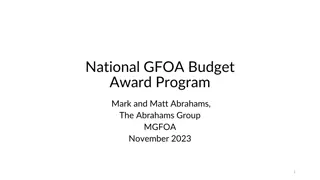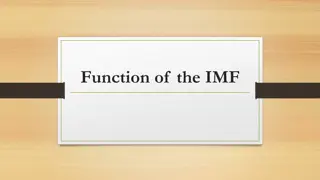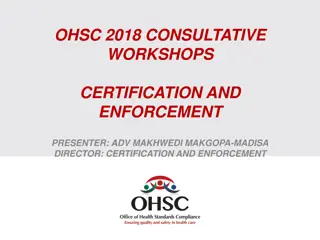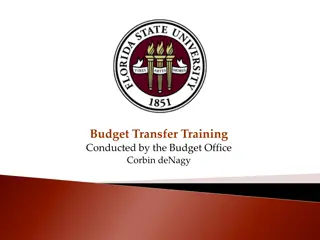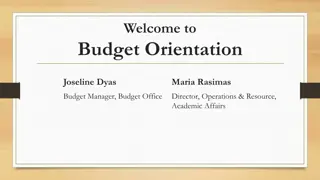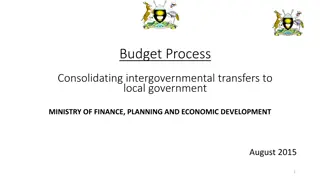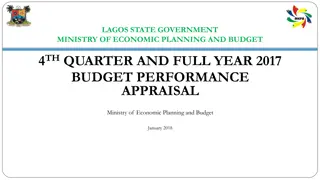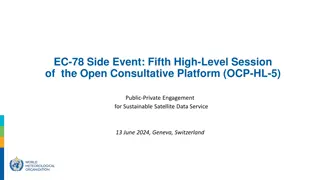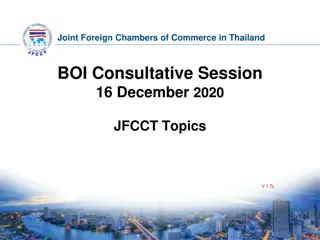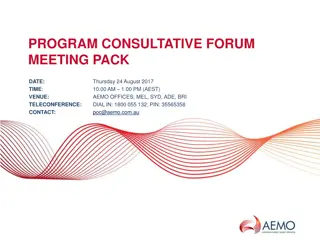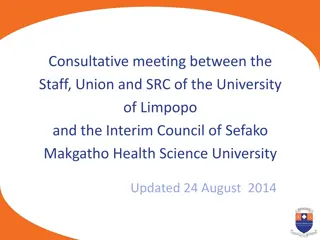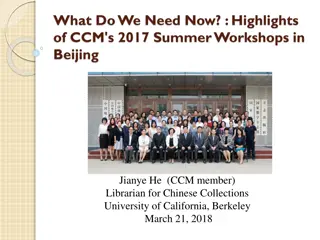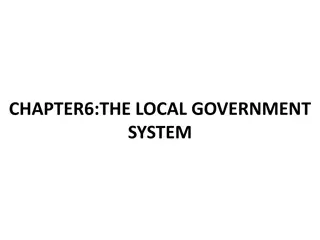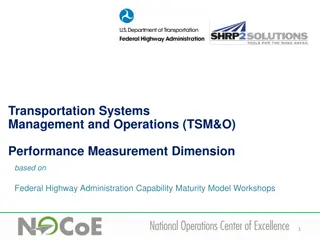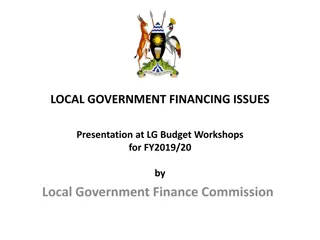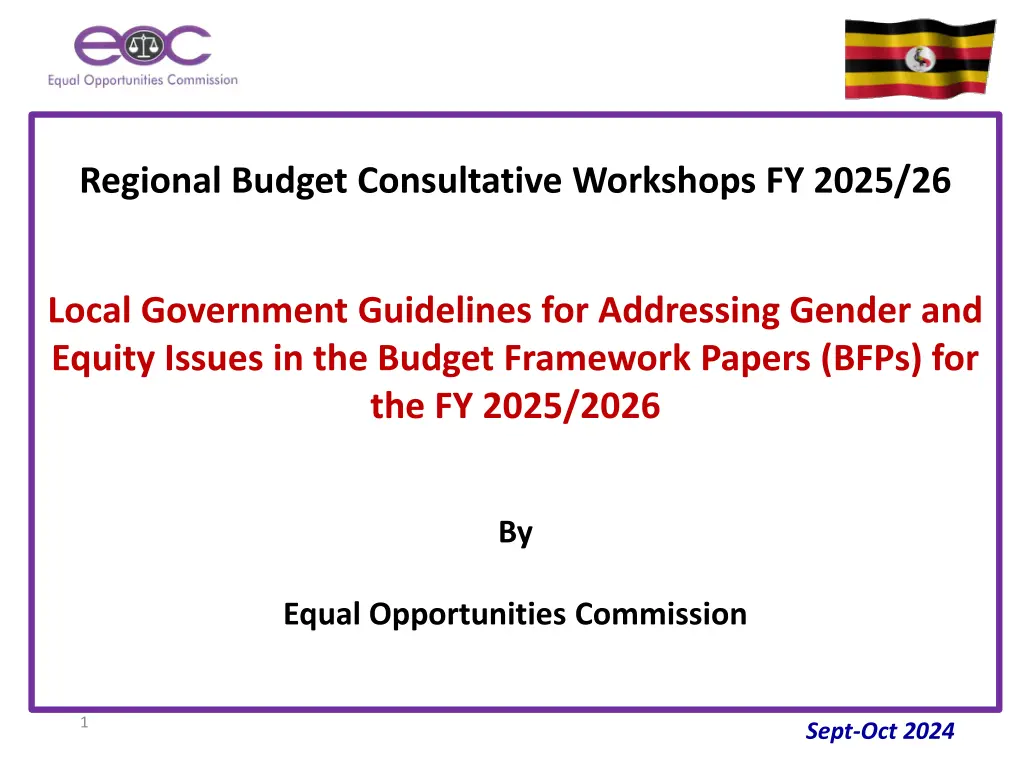
Regional Budget Consultative Workshops FY 2025/26 Overview
Explore the guidelines for addressing gender and equity issues in the budget framework papers for the FY 2025/2026 presented by the Equal Opportunities Commission. Understand the importance of compliance with gender and equity standards in local government budgeting and planning processes. Learn about key concepts such as gender issues, gender equality, equity, and gender and equity budgeting. Dive into the assessment of LG BFPs and emerging Equal Opportunities issues. Join the conversation on leaving no one behind in the 2030 Global Agenda.
Download Presentation

Please find below an Image/Link to download the presentation.
The content on the website is provided AS IS for your information and personal use only. It may not be sold, licensed, or shared on other websites without obtaining consent from the author. If you encounter any issues during the download, it is possible that the publisher has removed the file from their server.
You are allowed to download the files provided on this website for personal or commercial use, subject to the condition that they are used lawfully. All files are the property of their respective owners.
The content on the website is provided AS IS for your information and personal use only. It may not be sold, licensed, or shared on other websites without obtaining consent from the author.
E N D
Presentation Transcript
Regional Budget Consultative Workshops FY 2025/26 Local Government Guidelines for Addressing Gender and Equity Issues in the Budget Framework Papers (BFPs) for the FY 2025/2026 By Equal Opportunities Commission 1 Sept-Oct 2024
Outline of Presentation 1. Introduction 2. Definition of key Concepts 3. Emerging Equal Opportunities issues from Assessment of LGBFPs and Tracking 4. Summary Checklist for LG BFP Compliance with Gender and Equity issues 5. Conclusion 2 Sept-Oct 2024
Introduction Section 9 (6) (a) and (b) of the PFMA, 2015 requires LGs to ensure that LGBFPs are G&E compliant so as to be issued a Certificate of Compliance. The Certificate is issued by the Minister responsible for Finance Planning and Economic Development in consultation with the Equal Opportunities Commission. The G&E planning and budgeting approach is a strategy to ensure that the different needs and interests of Men, Women, youth, Special Needs Education Children, ethnic minorities, older persons, the rural poor, marginalised groups and disadvantaged regions and or locations are considered in the BFPs in a concerted effort of leaving no one behind as committed under the 2030 Global Agenda /17 SDGs. 3 Sept-Oct 2024
Introduction Cont All LGBFPs are subjected to assessment for compliance with Gender and Equity focusing on eight (8) departments namely: Production and Marketing/Trade; Industry and Local Development; Health; Education; Works and Engineering; Natural Resources; Community Based Services and the Support departments (Planning, Statutory, Audit, Finance and Administration). The existing G&E guidelines are integral part of the planning and budgeting process to support LGs in preparation of BFPs that meet the expected standards of compliance with gender and equity for the FY 2025/2026. 4 Sept-Oct 2024
B. DEFINITION OF KEY CONCEPTS Gender Issue: A statistical or social indicator of inequality between males and females arising from discrimination and/or marginalization. Gender Equality: Provision of equal opportunities to access, participate and use public services to all women and men. Equity: Equity refers to fairness and justice in the distribution of benefits, rights and responsibilities in society. Gender and Equity budgeting: It is about accommodating the different needs and interests of women and men, girls and boys, marginalized groups and regions/locations, gender and equity budgeting does not mean a separate budgeting process for women and marginalized groups. 5 Sept-Oct 2024
Emerging EO Issues from Assessment of LGBPs i. Limited consultations during planning and budgeting. Failure to consult the beneficiaries at different levels results into unequal distribution of resources by location. ii. Staffing Gaps in Local Governments with most of the staff being in acting positions which limit the LGs capacity in making strategic decisions. iii. Non-absorption of funds which has created a gap in meeting the local government expectations of timely access to quality services by the locals for inclusiveness, improving Household income and fully participation of people. iv. Delayed implementation of PDM Pillars. Out of the seven pillars, government has focused on one pillar of financial inclusion leaving out other six pillars. 6 Sept-Oct 2024
Emerging Gender and Equity Issues from Assessment of LGBPs Contn v. Lack of gender and equity disaggregated data broken down to local government level to guide planning and budgeting. vi. Inadequate Health Staff Houses. Staff accommodation remains a daunting challenge in the delivery of critical health services where staff continue to reside far away from health facility hence failure to attend to patients. vii. Limited access to education facilities for children with disabilities for example in Eastern Region Ngora School for the Deaf in Ngora district is the only school in the region accommodating children with hearing impairments in the Sub Region. 7 Sept-Oct 2024
Emerging Gender and Equity Issues from Assessment of LGBPs Contn viii.High HIV/AIDS Prevalence in Mbarara City due to limited awareness on HIV transmission and uptake of unsafe sex practices. Ix . Effects of floods in prone areas of Kasese district which has caused the closure of several schools, including Mt. Rwenzori Girls Secondary School, Bulembia Primary School and Katiri Primary School due to inaccessibility for students and staff. Xi. Delay in completion of the contracted works due to either late or no release of funds rendering the projects to be abandoned and this cut across all the districts. Xii. Direct implementation of projects by the centre which jeopardizes the realization of the intended out-comes and also demotivates the staff in the districts. 8 Sept-Oct 2024
Checklist for LG BFP Compliance with G&E Issues Section 1: Contribution to the National Development Priorities (6) The 1st section of the BFP deals with examination of LG policies and objectives with a G&E perspective for inclusive growth. It illustrates how the LG relates to the National Development Priorities in accordance with the Vision 2040 and the 5 yrs NDP IV and how it commits to address G&E issues identified; Step 1: Highlight clearly how your LG promotes; gender equality, equity, social inclusion and participation; the goal of the Vision 2040 (1 point) Step 2: Ensure that the at least one of the LG objectives addresses gender and equity concerns or all-inclusive/Universal (5 points) Inclusive/universal objectives imply that they will cater for all Ugandans. for example, provision of safe water to all 9 Sept-Oct 2024
Checklist for LG BFP Compliance with G&E Issues Section 2: Past performance (64 points) Under this section, LGs must highlight gender and equity specific out puts realised during the period under review. This section must demonstrate how the LG has addressed the needs and interests of different groups. Past performance will be assessed out of 64 points and the users should do the following; Step 1: Under physical performance in every department, indicate outputs attained against the 3 quarter achievements of the financial year under review with regard to addressing gender and equity issues (by age, disability and region/location) in the LG and mention the performance gaps. (32 points) Step 2: Specify amount utilized on outputs in every department that address gender and inequity (age, disability and location) during the period under review (32 points). 10 Sept-Oct 2024
Checklist for LG BFP Compliance with G&E Issues Section 3: Medium-Term Plans (5 points) This section must highlight the gender and equity LG plans in the medium term. In this regard, users should outline Gender and Equity responsive interventions planned for in the medium term. Medium-Term Plans will be assessed out of 5 points. The Users are required therefore to; Step 1: Specify gender and equity targeted interventions for the medium term to ensure inclusive service delivery (5 points) 11 Sept-Oct 2024
Checklist for LG BFP Compliance with G&E Issues Section 4: Plans and Allocation of Resources for the Ensuing Year (40 points) This section examines the plans and budget allocations for the ensuing financial year. In this regard, users should Step 1: Outline gender and Equity responsive outputs or activities planned for in the ensuing Financial Year in every department. (32 points) Step 2: In addition, allocated resources for all the gender and equity specific outputs (by age, disability and location) planned for in the ensuing year must be highlighted in every department (32 points) Plans and allocation of specific resources towards gender and equity for the ensuing year will be assessed out of 64 points 12 Sept-Oct 2024
Checklist for LG BFP Compliance with G&E Issues Section 5: LG Challenges (16 points) This section helps users identify and list all the shortcomings in addressing the gender and equity related issues while executing their plans and budgets. Users should ensure that they; Step1: Identify internal and external challenges as well as emerging issues that will affect the LG performance in addressing gender and equity issues. Use sex, age, and disability and location specific data to show the magnitude of gender and equity problems in your LG (8 points) Step 2: Propose solutions as well as complementary actions and responsible actors to enhance LG performance to address the identified gaps (8 points) 13 Sept-Oct 2024
Conclusions The Local Governments is pivotal in the implementation of G&E. Gender and equity planning and budgeting is a need for sustainable inclusive growth and development. This is in line with the Uganda Vision 2040 14
Thank You for listening 15

